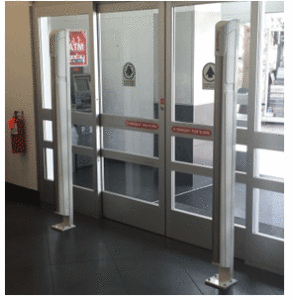The United Kingdom police arrested people involved in a shoplifting ring this past week, The New York police in the United States arrested 3 people involved in a shoplifting ring, and 3 more people are arrested in Delaware for the same crime last week. Shoplifting is a crime that in Europe, The United States, and other developed countries is so widespread that is costing businesses billions of dollars a year, and authorities are trying to find a solution to a problem that so far has no end in sight.
For more about this and other stories, follow the links below.
Can Science Stop Stealing? UF Researcher Aims to Find Out
University of Florida Research Scientist Dr. Read Hayes is gathering data to better understand shoplifters’ habits.
By Stephen Sellner · May 20, 2016
Dr. Read Hayes started the Loss Prevention Research Council 30 years ago. There, he studies video surveillance supplied by retailers to study shoplifting tendencies and better understand what deters them from stealing. Part of Hayes’ research involves interviewing shoplifters who are caught in the act to learn more about how they operate and what entices them to steal certain items. In exchange for talking, Hayes gives them a gift card to the store.
“We’re trying to really understand the thought process,” Hayes told Fox 13 News. “We’ve got to understand the psychology here in order for us to help influence their decisions.”
Below is a video that goes into more detail on Hayes’ work that has retailers very interested.
Delaware troopers arrest 3 in organized shoplifting
Delaware State Police troopers have arrested three people in connection with an organized retail theft operation.
Around 8:40 p.m. Saturday, May 28, troopers were dispatched to the Marshall’s store at 4575 Coastal Highway for a report of a shoplifting in progress, police said. When the troopers got there they saw a loss prevention employee chasing after three people running from the store, police said, and the troopers were able to detain the three suspects without further incident.
Police said the investigation revealed the three were removing security devices from clothing in the store and then concealing them in a backpack which they also took from the store’s sales rack. When the loss prevention employee confronted the three and identified himself, they dropped the merchandise and fled, police said.
East Cambridgeshire Police’s crime reduction officer has launched her ‘Sue’s Essentials’ project by handing out boxes of toiletries and sanitary items to colleges across the region.
The case of a 12-year-old girl caught shoplifting toiletries in Ely inspired Sue Loaker to kick-start ‘Sue’s Essentials’ – an initiative that aims to reduce crime – theft in particular – through the distribution of free toiletries, sanitary items and underwear.
Toothbrushes, sanitary towels, hairbrushes and bras are just a selection of goods on offer to teenagers who may be unable to buy the items themselves or may not be receiving them at home.
Ms Loaker believes that offering the items to the region’s young people for free can help reduce the number of teenage shoplifters, and hopes it will also aid in the prevention of bullying in schools.
She said: “Ultimately, it’s a self esteem issue, and not having these items can lead to bullying and crime.


 Is your burglar alarm giving you all it’s got? Technology keeps updating but there is one area you may not be thinking about getting more from your dollar: your burglar alarm system.
Is your burglar alarm giving you all it’s got? Technology keeps updating but there is one area you may not be thinking about getting more from your dollar: your burglar alarm system. Often overlooked for small businesses is the dire need for a suitable burglar alarm system. I talk about EAS placement and CCTV all the time. Those are rendered absolutely useless is someone busts in through the back door. If your burglar system isn’t up to standards, you run the risk of losing everything.
Often overlooked for small businesses is the dire need for a suitable burglar alarm system. I talk about EAS placement and CCTV all the time. Those are rendered absolutely useless is someone busts in through the back door. If your burglar system isn’t up to standards, you run the risk of losing everything. You know, sometimes we seem to overthink EAS tagging. Very often, I find that my store managers will focus so heavily on tagging a small, inexpensive (but high shrink) item, that they completely overlook the big ticket item that is absent of any physical security measure. Why is that? A large cooler is just as susceptible to loss as a pair of socks. Maybe it has to do with the perception of what is driving shrink in our stores.
You know, sometimes we seem to overthink EAS tagging. Very often, I find that my store managers will focus so heavily on tagging a small, inexpensive (but high shrink) item, that they completely overlook the big ticket item that is absent of any physical security measure. Why is that? A large cooler is just as susceptible to loss as a pair of socks. Maybe it has to do with the perception of what is driving shrink in our stores.
 Burnout is an on-going, serious issue in the retail industry. The industry is so immense and pervasive that all of us, even if we’ve never working in retail, have knowledge of and experience with the problem.
Burnout is an on-going, serious issue in the retail industry. The industry is so immense and pervasive that all of us, even if we’ve never working in retail, have knowledge of and experience with the problem. Over the past five years or so, social media platforms have exploded. Sites like Facebook, Twitter, or Instagram are essentially a one stop shop for all your news, entertainment and whatever your Aunt Dolly is doing today… Like most Americans, I visit these websites frequently throughout the day (although, I am weaning myself off this addiction slowly, but surely). Businesses have also been quick to jump on the bandwagon and have found that direct to consumer marketing, especially the free kind of marketing, can really help a small business soar. With so many people, places and things interconnected, you can see how the Loss Prevention Industry uses these platforms to not only aid in investigations, but to help track down fencing operations, retail ORC groups and even dishonest employees.
Over the past five years or so, social media platforms have exploded. Sites like Facebook, Twitter, or Instagram are essentially a one stop shop for all your news, entertainment and whatever your Aunt Dolly is doing today… Like most Americans, I visit these websites frequently throughout the day (although, I am weaning myself off this addiction slowly, but surely). Businesses have also been quick to jump on the bandwagon and have found that direct to consumer marketing, especially the free kind of marketing, can really help a small business soar. With so many people, places and things interconnected, you can see how the Loss Prevention Industry uses these platforms to not only aid in investigations, but to help track down fencing operations, retail ORC groups and even dishonest employees.
